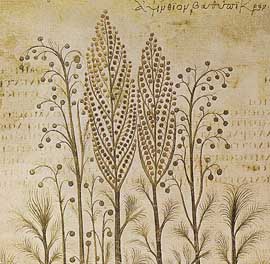- Glass Making in Roman Times
- Roman Wine: A Window on an Ancient Economy
- Roman Wine: Windows on a Lifestyle
- Fine Glassware in the Roman World
- Reuse of Images in the Art of Rogier van der Weyden
A Choice of Herbs

Pontic Wormwood (Artemisia absinthium)
Dioscorides' De Materia Medica
5th century A.D.
Many of these herbs, such as gentian and hazelwort, could be found on the local hillsides; others, such as rue and marjoram, came from carefully tended kitchen gardens. Certain shrubs—particularly juniper and myrtle—were popular for this purpose as well. Wealthy folk made a point of buying wines that had been spiced with herbs that were imported from afar—saffron from Cilicia, cardamom from the Malabar Coast of India, and resinous myrrh from from Arabia, so that a supper table must at times have smelled more like a perfumers' store than a place to eat.
A concoction of herbal favorings that yielded something akin to a modern absinthe also was popular:
"To make absintium...use an uncium of clean ground wormwood from Pontus, one date from Thebes, 3 scripulos of mastic and of aromatic leaf, 6 scripulosof costus root, 3 scripulos of saffron, 18 sextarii of appropriate wine. It is necessary to use charcoal to remove its bitterness." (Apicius' De Re Coquinaria: recipe 3)
Though wormwood is a very bitter herb, it has been an ingredient of aperitifs and herbal wines for centuries past: this, despite the fact that one of its principles, thujone, is toxic to the brain and the liver. Habitual use causes hallucinations and the kind of excitability made famous by the French artist, Vincent van Gogh, who surely was addicted to absinthe during the last years of his life.
